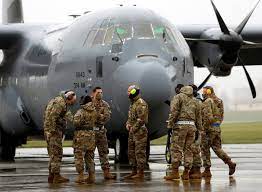This contract is, formally, “Guided Bundle Derivative of Silent Arrow for Side Door and Palletized Swarm Deployment at High Speeds and Altitudes,” with the drones themselves deemed Precision Guided Bundles. That’s a mess of a program name, but it tells a story in pieces. In 2019, Silent Arrow exhibited a large version of their cargo drone that could be released from the loading ramps of large transport planes.
The new contract is for a similar style of vehicle, roughly one fourth the volume and just under half the length of their existing cargo drone. “Palletized Swarm Deployment” is about launching multiple of these drones at once, from the side and rear doors of cargo planes, so that the cargo can travel in several small bundles instead of one big package.
The Precision Guided Bundles will have a maximum weight of 500 pounds apiece, with capacity for 350 pounds of cargo inside, as set out in the new specifications. The drone bundles will be at most 39 inches long, or just a little over 3 feet, and they can be released from a cargo plane at high altitudes and speeds, though exactly what altitudes and speeds was not specified.
What is most striking is the drone’s proposed range. Silent Arrow’s existing cargo glider drone can land 40 miles away from where it is launched. That’s the same distance that military parachutists can travel in high-altitude high-opening drops. (These are distinct from High Altitude Low Opening, or HALO, drops, where the plane has to be relatively close to the ultimate landing zone).
When soldiers and special forces jump from a plane at high altitude and distance, they can guide their parachutes to a landing zone miles and miles away. Putting guidance systems on the cargo that launches with the troops means when soldiers arrive, they can have some of what they need for a sustained fight or a longer mission.
For years, the military has explored different technologies to bring meals, ammunition and other supplies on such long-distance jumps. In the 1990s, the Air Force and Army started developing the Joint Precision Airdrop System, which attached to cargo parachutes and could steer them by pulling guidelines and following GPS. That system first saw use in Afghanistan in 2006.
Silent Arrow offers a smaller payload than some of the parachute drops, but makes up for it by being able to launch from smaller aircraft. This specifically includes the Cessna Caravan, a single-engine light transport that serves as the basis for the AC-208 Combat Caravan, a military version used by Special Operations Command. The flexibility to launch from small planes gives the military the option to send discreet support that doesn’t involve screaming jet engines.
Source : https://www.popsci.com/technology/usaf-tests-cargo-drones/







